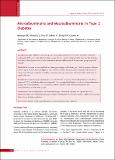Please use this identifier to cite or link to this item:
https://hdl.handle.net/20.500.14356/2027Full metadata record
| DC Field | Value | Language |
|---|---|---|
| dc.contributor.author | Maharjan, B R | - |
| dc.contributor.author | Bhandary, S | - |
| dc.contributor.author | Risal, P | - |
| dc.contributor.author | Sedhain, A | - |
| dc.contributor.author | Gautam, M | - |
| dc.date.accessioned | 2023-06-06T06:24:35Z | - |
| dc.date.available | 2023-06-06T06:24:35Z | - |
| dc.date.issued | 2010 | - |
| dc.identifier.citation | MaharjanB. R., BhandaryS., RisalP., SedhainA., & GautamM. (2011). Microalbuminuria and Macroalbuminuria in Type 2 Diabetes. Journal of Nepal Health Research Council. https://doi.org/10.33314/jnhrc.v0i0.238 | en_US |
| dc.identifier.issn | Print ISSN: 1727-5482; Online ISSN: 1999-6217 | - |
| dc.identifier.uri | http://103.69.126.140:8080/handle/20.500.14356/2027 | - |
| dc.description | Original Article | en_US |
| dc.description.abstract | Abstract Background: Type 2 diabetes is the leading cause of end stage renal disease worldwide. Prevalence of diabetic nephropathy (DN) varies in the different ethnic groups. Nepal is country with great ethnic diversity. This study has been done to find the prevalence of microalbuminuria and macroalbuminuria in the two ethnic groups Jyapu and Brahmin. Methods: In our study we have included two ethnics groups Jyapu and Brahmin type 2 diabetic patients. Inclusion criteria: Age ≥ 30 years, clinically diagnosed type 2 diabetic patients. Exclusion criteria: Patients with a history of urinary tract infection, hematuria, renal failure, intercaste marriage and women with menstruation at the time of sample collection. Results: The overall prevalence of albuminuria was 49.05%. The prevalence of microalbuminuria was 35.89% in Jyapu and 37.73% in Brahmin which was comparable. There was significantly higher prevalence of macroalbuminuria in Jyapu 20.75% and Brahmin 3.77%. Association of dietary habit was seen with microalbuminuria and macroalbuminuria in both ethnic groups. Conclusions: The overall prevalence of albuminuria in type 2 diabetes of our study was high and there was significantly higher macroalbuminuria in Jyapu compared with Brahmin. It, therefore, predicts a higher risk of having kidney disease in Jyapu population. | en_US |
| dc.language.iso | en_US | en_US |
| dc.publisher | Nepal Health Research Council | en_US |
| dc.relation.ispartofseries | Oct, 2010;238 | - |
| dc.subject | Ethnicity | en_US |
| dc.subject | Nepal | en_US |
| dc.subject | Macroalbuminuria | en_US |
| dc.subject | Microalbuminuria | en_US |
| dc.subject | Type 2 diabetes | en_US |
| dc.title | Microalbuminuria and Macroalbuminuria in Type 2 Diabetes | en_US |
| dc.type | Journal Article | en_US |
| local.journal.category | Original Article | - |
| Appears in Collections: | Vol 8 No 2 Issue 17 October 2010 | |
Files in This Item:
| File | Description | Size | Format | |
|---|---|---|---|---|
| 238-Article Text-236-1-10-20130822.pdf | Full text Article | 231.12 kB | Adobe PDF |  View/Open |
Items in DSpace are protected by copyright, with all rights reserved, unless otherwise indicated.
